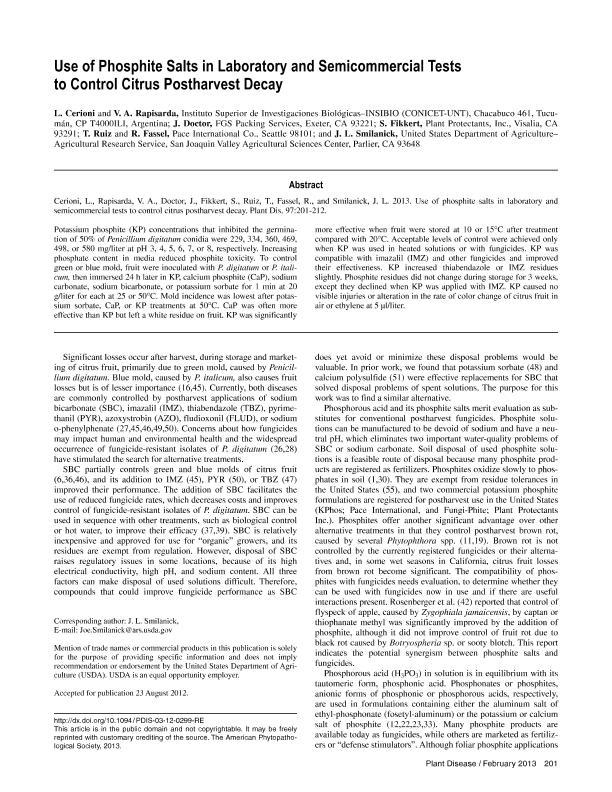Artículo
Use of phosphite salts in laboratory and semicommercial tests to control citrus postharvest decay
Cerioni, Luciana ; Rapisarda, Viviana Andrea
; Rapisarda, Viviana Andrea ; Doctor, J.; Fikkert, S.; Ruiz, T.; Fassel, R.; Smilanick, J. L.
; Doctor, J.; Fikkert, S.; Ruiz, T.; Fassel, R.; Smilanick, J. L.
 ; Rapisarda, Viviana Andrea
; Rapisarda, Viviana Andrea ; Doctor, J.; Fikkert, S.; Ruiz, T.; Fassel, R.; Smilanick, J. L.
; Doctor, J.; Fikkert, S.; Ruiz, T.; Fassel, R.; Smilanick, J. L.
Fecha de publicación:
02/2013
Editorial:
American Phytopathological Society
Revista:
Plant Disease
ISSN:
0191-2917
Idioma:
Inglés
Tipo de recurso:
Artículo publicado
Resumen
Potassium phosphite (KP) concentrations that inhibited the germination of 50% of Penicillium digitatum conidia were 229, 334, 360, 469, 498, or 580 mg/liter at pH 3, 4, 5, 6, 7, or 8, respectively. Increasing phosphate content in media reduced phosphite toxicity. To control green or blue mold, fruit were inoculated with P. digitatum or P. italicum, then immersed 24 h later in KP, calcium phosphite (CaP), sodium carbonate, sodium bicarbonate, or potassium sorbate for 1 min at 20 g/liter for each at 25 or 50°C. Mold incidence was lowest after potassium sorbate, CaP, or KP treatments at 50°C. CaP was often more effective than KP but left a white residue on fruit. KP was significantly more effective when fruit were stored at 10 or 15°C after treatment compared with 20°C. Acceptable levels of control were achieved only when KP was used in heated solutions or with fungicides. KP was compatible with imazalil (IMZ) and other fungicides and improved their effectiveness. KP increased thiabendazole or IMZ residues slightly. Phosphite residues did not change during storage for 3 weeks, except they declined when KP was applied with IMZ. KP caused no visible injuries or alteration in the rate of color change of citrus fruit in air or ethylene at 5 µl/liter.
Palabras clave:
Green Mold
,
Phosphite Salts
Archivos asociados
Licencia
Identificadores
Colecciones
Articulos(INSIBIO)
Articulos de INST.SUP.DE INVEST.BIOLOGICAS
Articulos de INST.SUP.DE INVEST.BIOLOGICAS
Citación
Cerioni, Luciana; Rapisarda, Viviana Andrea; Doctor, J.; Fikkert, S.; Ruiz, T.; et al.; Use of phosphite salts in laboratory and semicommercial tests to control citrus postharvest decay ; American Phytopathological Society; Plant Disease; 97; 2; 2-2013; 201-212
Compartir
Altmétricas



